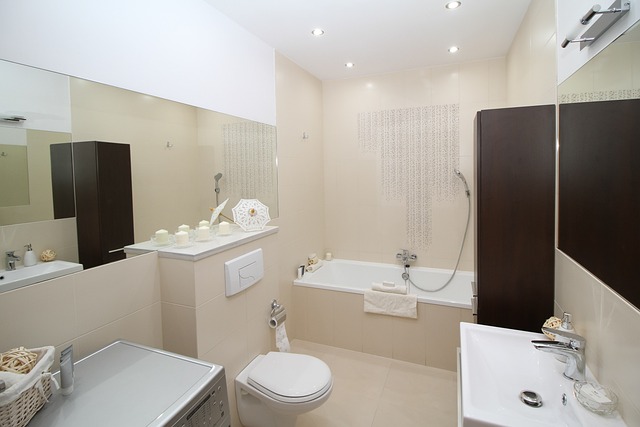An energy-efficient bathroom design leverages natural light through light-colored finishes and reflective surfaces to reduce electricity use while enhancing user experience. Strategically selecting colors, materials, and window placements maximizes sunlight, creating a bright, open space that feels larger. This approach not only saves costs and reduces carbon emissions but also contributes to a tranquil, environmentally conscious bathroom environment.
Discover the power of light! This article explores how using light-colored finishes can transform your space, enhance natural light, and significantly reduce electricity use. From understanding the impact of daylight on energy consumption to incorporating reflective materials, we guide you through effective strategies for an energy-efficient bathroom design. Learn which paint colors save energy and gain insights into creating a bright, sustainable living environment.
Understanding the Impact of Natural Light on Energy Consumption
Natural light is a powerful tool in reducing electricity use and creating an energy-efficient bathroom design. Studies show that well-lit spaces not only enhance the user experience but also significantly lower energy consumption compared to heavily reliant artificial lighting. The impact of sunlight on energy usage is multifaceted; during daylight hours, leveraging natural light can substantially decrease the need for electric lighting, translating to immediate cost savings and a reduced carbon footprint.
In an energy-efficient bathroom design, light-colored finishes play a pivotal role in maximizing natural light. These finishes reflect rather than absorb sunlight, allowing more of it to permeate the space. As a result, areas that were once dimly lit or reliant on artificial lighting can now bask in brightness, eliminating the need for excessive electricity use. This simple yet effective strategy not only contributes to environmental sustainability but also fosters a sense of openness and tranquility within the bathroom.
The Role of Light-Colored Finishes in Maximizing Daylight
Choosing the Right Paint Colors for Energy Efficiency
When designing an energy-efficient bathroom, selecting the right paint colors plays a significant role in enhancing natural light and reducing electricity usage. Light-colored paints, such as soft whites, creams, and pastels, are ideal for this purpose. They reflect sunlight rather than absorbing it, making your space feel brighter and more open. This reflection reduces the need for artificial lighting during the day, thereby lowering energy consumption.
In contrast, dark colors tend to absorb light, creating a cozier but potentially dimmer environment. For an energy-efficient bathroom, avoiding deep shades and opting for lighter tones can make a substantial difference in your home’s overall energy savings. Additionally, these colors create an illusion of space, making the room appear larger and more well-lit without excessive electricity use.
Incorporating Reflective Surfaces and Materials
In an energy-efficient bathroom design, incorporating reflective surfaces and materials is a strategic move to maximize natural light and reduce electricity consumption. Mirrors, for instance, can significantly enhance the brightness of a space by reflecting ambient light back into the room, creating an illusion of space and making smaller bathrooms appear larger. When paired with light-colored walls or floor tiles, mirrors become powerful tools in optimizing available light.
Beyond traditional mirrors, other reflective materials like stainless steel, glass, or even shiny ceramic tiles can contribute to a more open and well-lit atmosphere. These surfaces not only bounce light around but also help to keep the space feeling fresh and vibrant throughout the day, reducing the need for artificial lighting. In essence, thoughtful use of reflective elements is a key aspect of creating an energy-efficient bathroom design that leverages natural light effectively.
Design Strategies for an Energy-Efficient Bathroom
Creating an energy-efficient bathroom starts with strategic design choices that maximize natural light and minimize electricity consumption. One effective approach is to incorporate light-colored finishes on walls, ceilings, and floors. These surfaces reflect rather than absorb sunlight, flooding the space with bright, ambient light. This reduces the need for artificial lighting during the day, cutting down on energy usage. Additionally, selecting materials like vinyl or linoleum flooring offers both durability and cost-effectiveness while keeping heat loss to a minimum.
Further optimization can be achieved through strategic window placement and treatments. Large south-facing windows take full advantage of sunlight, providing ample illumination. Drapes made from light-reflecting fabrics or solar films can further enhance natural light while blocking heat gain during warmer months, reducing the burden on air conditioning systems. These design elements work together to create a bathroom that feels open, inviting, and significantly lowers energy bills.
Incorporating light-colored finishes is a simple yet effective strategy to transform your energy-efficient bathroom design. By maximizing natural light and minimizing heat absorption, these finishes significantly reduce electricity use for lighting, making it an environmentally friendly choice that benefits both your wallet and the planet. Remember, when designing your space, consider the power of reflective surfaces, and choose paint colors wisely to create a bright, inviting, and sustainable bathroom.
